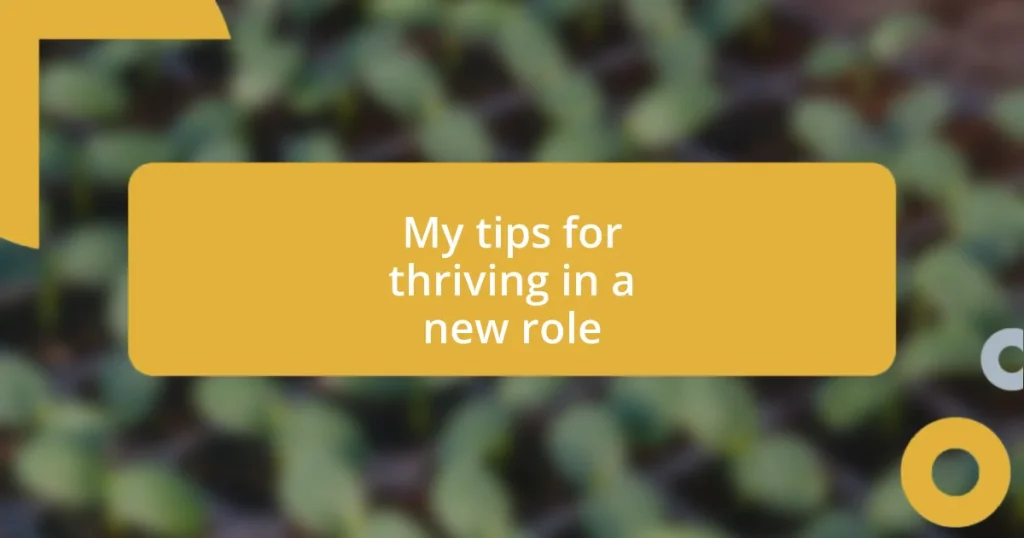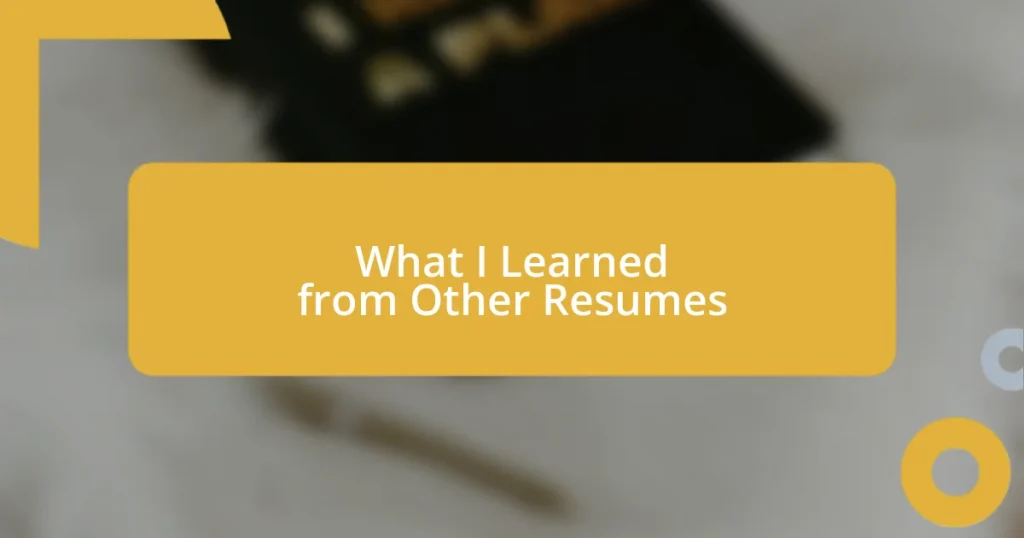Key takeaways:
- Assessing your skills and reflecting on past experiences can enhance clarity and confidence in navigating a new role.
- Understanding the company culture through engagement and observation fosters stronger relationships and a sense of belonging.
- Continuous learning and celebrating small wins contribute to personal growth, team morale, and a positive work environment.

Assess your current skills
Taking a close look at your current skills can be a real game-changer. I remember starting in a role where I felt overwhelmed by new responsibilities. It was only when I sat down to list my strengths—like problem-solving and communication—that I realized I could leverage these skills effectively.
Have you ever felt like you’re treading water, unsure of how your skill set fits into your new position? I certainly have. Once I recognized the transferable skills I had from previous jobs, such as managing projects or collaborating with teams, it became easier to navigate the challenges that lay ahead. Finding those connections can offer both clarity and confidence, helping pave your path to success.
Don’t underestimate the value of self-reflection either. Reflecting on past experiences can bring unexpected insights. I often journal about my abilities and experiences, which has helped me appreciate the nuances of my skills over time. This practice not only boosts my self-awareness but also keeps me grounded in challenging situations. What skills have helped you overcome obstacles in your career? Taking the time to assess them could be your key to thriving.

Understand company culture
To truly thrive in a new role, understanding the company culture is essential. I can recall stepping into an organization where the atmosphere was highly collaborative, unlike anything I had experienced before. Initially, I felt a bit lost, as I came from a more hierarchical environment where decisions were made at the top. By observing informal interactions and participating in team activities, I quickly grasped the underlying values and norms that drove the workplace dynamics.
Embracing this new culture not only made me feel more comfortable but empowered me to connect with my colleagues on a deeper level. Here are a few ways to navigate and understand the culture of your new workplace:
- Talk to Colleagues: Engage in conversations and ask about their experiences and what they value in the company.
- Observe Interactions: Pay attention to how people communicate—both formally in meetings and casually in day-to-day conversations.
- Participate in Events: Join social events or team-building activities to immerse yourself in the company’s atmosphere.
- Review Company Materials: Dive into company materials like mission statements, values, and employee handbooks to gain insight into organizational priorities.
- Seek out Mentorship: Find a mentor within the company who can guide you through the cultural nuances and help you get acclimated.
By taking these steps, not only did I feel more aligned with my role, but I also developed stronger relationships with my teammates, ultimately fostering a sense of belonging. What strategies have you found effective in understanding workplace culture? Each effort you make brings you closer to navigating your new environment seamlessly.

Build relationships with colleagues
Building strong relationships with colleagues can make a significant difference in how you thrive in a new role. I’ll never forget my first week at a new job; I made a point to introduce myself to everyone in my team. It felt a bit intimidating at first, but I quickly realized that a simple smile and a sincere “Hello” opened the door to meaningful conversations. These small interactions laid the foundation for trust, and my colleagues became my go-to support network as I navigated my new responsibilities.
Have you ever noticed how comfort levels can vary in a workplace? I’ve found that the best fitting relationships come from shared experiences and open dialogues. By seeking common interests or asking about their work, I created connections based on genuine curiosity. Sometimes, we would gather for coffee breaks, where I learned about their projects and aspirations, and in return, I shared my own. This reciprocal exchange transformed my coworkers into allies, and we built a collaborative environment that made tackling challenges much more enjoyable.
Investing time into team-building activities can also pay off significantly. I remember when our team organized a volunteer day to give back to the community. It was a fantastic opportunity to bond outside of the usual office setting. I felt a sense of camaraderie grow among us that day—everyone brought their unique personality to the table, from the jokester to the planner. These moments helped me understand my colleagues on a personal level, enabling me to forge deeper connections that proved invaluable during high-pressure situations.
| Strategy | Description |
|---|---|
| Initiate Conversations | Start conversations with colleagues to break the ice and discover shared interests. |
| Ask Questions | Inquire about their experiences and roles to learn how you can support each other. |
| Participate in Social Activities | Engage in team outings or events to foster friendships and build rapport. |
| Follow Up | Check in with colleagues regularly to maintain and strengthen those relationships. |

Set clear goals and expectations
Setting clear goals and expectations is a crucial step when starting in a new role. I remember my first job in a tech startup. I felt overwhelmed by the fast pace and dynamic environment. It was only after I sat down with my manager to outline specific, measurable objectives that I began to feel a sense of direction. We broke down my responsibilities into smaller, actionable tasks, which made everything seem more manageable. I couldn’t help but wonder: wouldn’t it be easier for everyone if we all had a roadmap from day one?
When expectations are transparent, it transforms ambiguity into clarity. I’ve noticed that without defined goals, I often found myself second-guessing my actions and decisions. During one project, our team set weekly check-ins to review progress against our goals. It was incredibly motivating! I felt accountable, not just to myself but to the whole team, and those sessions became a highlight of my week. Have you ever experienced that spark of excitement when you can clearly see your progress?
Moreover, being able to adjust goals as you learn more about your role is equally vital. I often felt that I was growing into my position in real-time. Once, after a few weeks of feedback and reflection, I realized the initial targets we set were too ambitious. I brought this up in a meeting, and my manager was surprisingly receptive. We tweaked our expectations together, aligning them with what was realistically achievable. This experience taught me that setting goals is not a one-time affair; it’s an evolving process that should adapt to your journey. So, what steps will you take to establish and refine your own goals in a new position?

Seek feedback regularly
Seeking feedback regularly is a game-changer, especially in a new role. I vividly remember how intimidating it felt to ask for input on my work. After submitting a project proposal, I hesitated before asking my manager for their thoughts. But once I took that leap, I realized how valuable that conversation was. Not only did it help clarify my direction, but it also showed my willingness to learn and grow. What if I’d never asked? I would have missed out on key insights that ultimately shaped my success.
Another aspect of feedback that I find crucial is the informal check-ins. Sometimes, I shoot a quick message to a colleague after a meeting, asking how I could have communicated my ideas better. One day, a coworker told me that my passion sometimes overshadowed my points. This gentle nudge helped me refine my communication style. It’s funny how a few words can shift our perspective, isn’t it? I learned that feedback doesn’t always have to come from formal channels; it can be a casual conversation that sparks significant improvement.
Moreover, I make it a habit to create a feedback loop. This means I don’t just seek feedback; I also reflect on it and act upon it. After implementing suggestions from my last project review, I revisited my manager to share the changes I made. Their surprised expression told me it had a positive impact—an affirmation that made me feel accomplished. Have you ever taken feedback and turned it into a stepping stone for your growth? Regularly seeking and responding to feedback creates a culture of continuous improvement in both yourself and your team.

Embrace continuous learning
Embracing continuous learning is essential in any new role, and I’ve truly seen this reflected in my own experiences. I remember when I stepped into my first management position; it felt like a whirlwind of new responsibilities. Instead of feeling overwhelmed, I saw it as an opportunity to dive deep and soak up as much knowledge as I could. I signed up for workshops and enrolled in online courses, eagerly devouring everything from leadership techniques to conflict resolution strategies. Who knew that the more I learned, the more confident and capable I would feel?
One eye-opening moment for me was attending a conference where industry leaders shared their insights. I still vividly recall a panel discussion that challenged my perspective on my work. I walked away with fresh ideas and a renewed sense of purpose. It sparked a question in me: how could I incorporate these new insights into my daily routine? The beauty of continuous learning is that it constantly broadens our horizons. Every new piece of information feels like a puzzle piece fitting into the bigger picture of my career.
Additionally, I’ve found that sharing what I learn can be just as rewarding as the learning process itself. For example, I once led a lunch-and-learn session on the agile methodology after I completed a course on it. As I explained the concepts to my colleagues, I noticed how our discussions ignited new thoughts and ideas. It became a dynamic exchange of knowledge instead of a one-sided lecture. Have you ever had that moment when teaching something actually cemented your understanding even more? Embracing continuous learning isn’t just about personal growth; it’s about enriching the entire workplace environment.

Celebrate small wins
Celebrating small wins can be a transformative practice in a new role. I remember the first time I nailed a presentation; it was just a simple team meeting. But the rush of excitement I felt when my colleagues complimented my insights was invigorating. Why do we often overlook these moments? Each small win is a stepping stone that builds our confidence and pushes us forward.
In my experience, taking time to acknowledge these achievements fosters a positive mindset. There was a week when I managed to complete three significant tasks ahead of schedule. Instead of letting the moment pass, I treated myself to a nice dinner to mark the occasion. This simple act of recognition not only boosted my morale but also motivated me to keep that momentum going. Have you ever paused to celebrate your victories, no matter how small? It’s amazing how it can rekindle your passion for your work.
Additionally, sharing these small wins with others can amplify their impact. I make it a point to express gratitude and celebrate my team’s efforts during our weekly catch-ups. Once, after we finished a challenging project, I brought in treats to share. Seeing everyone’s smiles as we toasted to our success created a sense of unity and accomplishment. Isn’t it powerful how celebrations, no matter how modest, can strengthen bonds within a team while encouraging a culture of appreciation?















